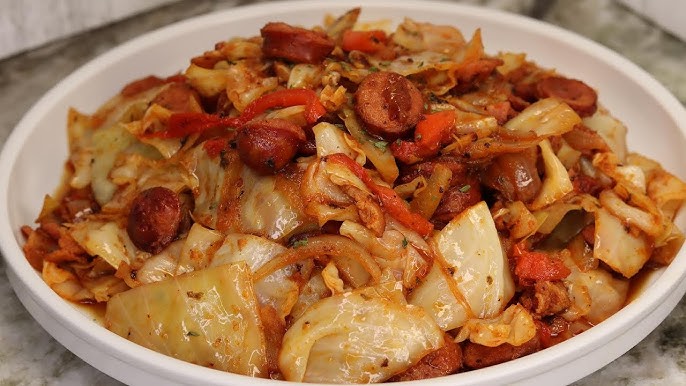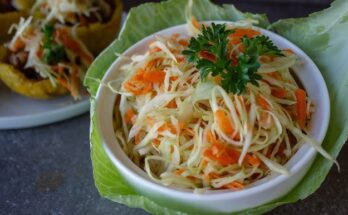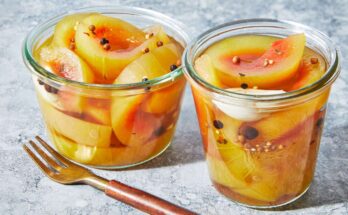Southern Cabbage Recipe: If you’ve never tried Southern cabbage, you’re in for a real treat. Southern-style cabbage is the epitome of down-home comfort food. It’s a dish steeped in tradition, passed down through generations in Southern kitchens. It’s hearty, it’s flavorful, and it’s soul-satisfying. When cooked right, cabbage transforms from a humble, crunchy vegetable into a soft, buttery delight that absorbs every bit of seasoning you throw at it. Whether it’s paired with smoked meat, served alongside cornbread, or enjoyed as a standalone dish, Southern cabbage is the kind of recipe that hugs your taste buds and warms your soul.
The beauty of this dish is in its simplicity. With just a few staple ingredients, you can whip up a meal that feels like a Sunday dinner at grandma’s house. It’s a great choice for weeknight dinners, Sunday suppers, or potlucks where you want to impress with minimal fuss. And here’s the best part—it’s super affordable, too!
Why This Recipe Stands Out
What makes this Southern cabbage recipe truly shine is its balance of rich, savory flavors and soft, melt-in-your-mouth texture. The cabbage is gently cooked until tender, but not mushy, and seasoned just right. The secret is in the layering of flavors—starting with onions and garlic sautéed in fat (bacon grease, butter, or oil), and then simmered slowly with the cabbage to infuse every leaf with deliciousness.
This dish is also incredibly versatile. Whether you’re cooking for vegetarians or meat lovers, it adapts beautifully. Add smoked sausage, bacon, or ham hock if you’re looking for a meatier dish. Keep it simple with just the veggies and spices for a lighter version. It works as a side dish, but it’s hearty enough to be the star of your plate.
List of Ingredients You’ll Need
Fresh Produce and Basics
To get started with your Southern cabbage, you’ll need some basic, easy-to-find ingredients. Here’s what you’ll want to gather:
- 1 large head of green cabbage – Choose one that’s heavy for its size and has tight, crisp leaves.
- 1 large yellow onion – Adds natural sweetness and depth.
- 2-3 cloves of garlic – Fresh garlic is key for that aromatic base.
- 2 tablespoons of butter or bacon grease – Adds richness to the dish.
- 1/4 cup of chicken broth or water – Helps steam the cabbage while infusing flavor.
These ingredients form the base of the dish and are non-negotiable for that classic Southern flavor. The cabbage is the star, but the onions and garlic build the flavor profile from the ground up.
Spices and Seasonings
No Southern dish is complete without a generous helping of spices. For this cabbage recipe, you’ll want to have:
- Salt and black pepper – To taste. Always start light, then adjust.
- 1/2 teaspoon of smoked paprika – For a hint of smoky depth.
- 1/2 teaspoon of crushed red pepper flakes (optional) – For a touch of heat.
- 1/2 teaspoon of sugar – Balances out the bitterness in the cabbage.
- Optional: a dash of apple cider vinegar – Adds a slight tang that brightens up the dish.
Seasoning is where you make the dish your own. Like it spicy? Add a little more red pepper. Want it more savory? Up the paprika or add garlic powder. This flexibility is part of what makes Southern cooking so personal and satisfying.
Optional Add-Ins for Extra Flavor
Want to take your cabbage to the next level? Here are some add-ons that Southern cooks swear by:
- Bacon (4-5 strips, chopped and cooked until crispy)
- Smoked sausage (sliced and browned)
- Ham hocks or leftover ham
- Bell peppers (sliced thinly for added color and sweetness)
- Carrots (julienned or thinly sliced for sweetness and color)
These optional ingredients give your cabbage that extra layer of flavor and heartiness, turning it from a humble side dish into the main event. Bacon and smoked sausage in particular add a savory punch that’s downright irresistible.
Kitchen Tools and Equipment
Essentials for Cooking Southern Cabbage
You don’t need a fancy kitchen to make this dish. But a few basic tools will make the job smoother:
- Large skillet or Dutch oven – Needs to be big enough to handle a whole head of cabbage.
- Sharp chef’s knife – For slicing cabbage and onions with ease.
- Cutting board – Preferably one dedicated to veggies.
- Measuring spoons – For accurate seasoning.
A large, heavy-bottomed skillet or Dutch oven is perfect for this kind of slow-cooked dish. It distributes heat evenly and holds in moisture, allowing the cabbage to steam and sauté to perfection.
Tools That Make It Easier
If you cook Southern meals often, these tools can save you time:
- Mandoline slicer – For ultra-thin cabbage shreds.
- Garlic press – If you’re not a fan of chopping garlic by hand.
- Lid for your skillet – Helps trap steam while cooking the cabbage.
These aren’t essential, but they’ll speed up your prep and help you get a consistent result every time. Especially when you’re cooking for a crowd, shaving minutes off prep time can make a big difference.
Preparation Tips Before Cooking
How to Select the Perfect Cabbage
When you’re at the store or farmer’s market, look for a firm, tightly-packed cabbage. Avoid any that have soft spots, brown edges, or loose leaves—these are signs that the cabbage is old or starting to spoil. Ideally, the head should feel heavy for its size, indicating it’s packed with moisture and freshness.
Color matters too. A bright green cabbage is usually fresher and more flavorful. If you’re in the mood to experiment, Napa cabbage and Savoy cabbage also work for this recipe, but traditional green cabbage is the most authentic for Southern-style dishes.
Before cooking, peel off the outer 1-2 leaves and give the whole head a good rinse under cold water. Dry it off with a clean towel before cutting—it helps avoid soggy cabbage later.
Proper Washing and Chopping Techniques
Cutting cabbage doesn’t have to be complicated. Follow these easy steps:
- Remove outer leaves and rinse the cabbage.
- Cut the head in half through the stem.
- Remove the core by cutting a V-shaped wedge at the base of each half.
- Slice the cabbage into strips about 1/2 inch wide—or thinner if you want it to cook faster.
Washing your cabbage thoroughly is important, especially if you’re buying it fresh from a local market. Dirt and bugs can sometimes hide between the leaves. Soak it in a large bowl of water for a few minutes, then rinse well and pat dry.
Step-by-Step Guide to Cooking Southern Cabbage
Step 1 – Prepping Your Ingredients
First things first—prep everything before you start cooking. That means:
- Chop the cabbage
- Dice the onion
- Mince the garlic
- Cook your bacon or sausage (if using)
Having everything ready to go makes the cooking process smooth and stress-free. Once the cabbage hits the pan, things move quickly, so you don’t want to be chopping last minute. It’s the classic mise en place method—everything in its place.
Once your bacon is cooked, don’t toss the grease! That’s Southern gold. It’s what makes the base of your flavor, so keep it in the pan for the next step.
Step 2 – Sautéing Onions and Garlic
Start by heating your butter or bacon grease in a large skillet or Dutch oven over medium heat. Add the diced onions and cook them until they’re soft and translucent—about 5 to 7 minutes. Then, toss in the minced garlic and cook for another 30 seconds to a minute, just until fragrant.
This step builds the flavor base for the entire dish. You’ll know it’s working when your kitchen starts to smell like home.
Step 3 – Adding the Cabbage
Once your onions and garlic are sautéed to perfection, it’s time to introduce the star of the show—the cabbage. Gently add the sliced cabbage to the skillet. Don’t worry if it looks like too much at first—cabbage wilts significantly as it cooks, reducing in volume by more than half.
If you’re using a large head of cabbage, add it in batches. Let each batch wilt slightly before adding more. This makes it easier to manage and ensures even cooking. Stir the cabbage into the onion and garlic mixture, coating it thoroughly in the flavorful base.
At this stage, season lightly with salt, pepper, smoked paprika, and a pinch of sugar. You’ll add more seasoning later, but this first layer helps build flavor early in the cooking process. If you’re going the extra mile with bacon or sausage, now’s the time to fold those in, too.
This is also where you can add your optional bell peppers or carrots if using. They not only bring extra flavor but also add a nice pop of color that makes the dish look even more appetizing.
Step 4 – Simmering to Perfection
After everything is combined, it’s time to let the flavors come together. Add about 1/4 cup of chicken broth or water to the pan. The liquid helps to gently steam the cabbage, making it tender without losing texture. Cover the skillet with a lid and reduce the heat to low or medium-low.
Let the cabbage simmer for 20 to 30 minutes, stirring occasionally. The longer it cooks, the more the flavors meld. You’re looking for a tender, melt-in-your-mouth texture, not soggy mush. Don’t rush this part—it’s the soul of the recipe.
If the cabbage starts to dry out or stick to the bottom, simply add a splash more broth or water. You want just enough moisture to keep things simmering smoothly without turning the dish into soup.
At the 15-minute mark, give it a taste and adjust the seasonings. A splash of apple cider vinegar at this stage can really brighten up the dish, cutting through the richness and balancing the savory depth.
Step 5 – Final Seasoning and Taste Test
Now we’re in the final stretch. The cabbage should be soft but still have a bit of bite, and the liquid should be mostly evaporated. This is the time to taste and tweak. Add more salt, pepper, or red pepper flakes depending on your preference. Like it a bit sweeter? A tiny pinch of sugar goes a long way. Want more tang? A bit more vinegar can do wonders.
If you’re cooking for a crowd, transfer the cabbage to a serving dish and top with crispy bacon or a sprinkle of fresh herbs like parsley for a pop of color and freshness.
And just like that, you’ve created an irresistible Southern cabbage dish that’s bursting with flavor and tradition.
Serving Suggestions and Pairings
What to Serve with Southern Cabbage
Southern cabbage is incredibly versatile and pairs beautifully with a variety of Southern staples. Whether you’re going for a full spread or a simple, hearty meal, here are some of the best options to serve alongside it:
- Cornbread – Golden, buttery, and slightly sweet, cornbread is a natural match. The soft, crumbly texture soaks up the savory juices from the cabbage perfectly.
- Fried Chicken – Crispy, juicy fried chicken pairs with cabbage like a dream. The crunchy coating complements the tender cabbage.
- Smoked or Grilled Sausages – If you haven’t added sausage directly to the cabbage, serving it on the side adds a smoky kick.
- Mashed Potatoes – Creamy mashed potatoes and cabbage make a comforting combo that’ll stick to your ribs.
- Pinto Beans or Black-Eyed Peas – For a soul food feast, these beans round out the plate and provide a great protein option.
You can also serve it with rice or grits if you’re looking to stretch the dish a bit further. The gentle flavor of the cabbage balances stronger meats and starches perfectly, making it the ideal side or centerpiece for your next Southern-style meal.
Southern Cabbage as a Main or Side Dish
While traditionally served as a side, Southern cabbage is hearty enough to stand on its own. Especially when you load it up with sausage, bacon, or ham hocks, it becomes a full meal in itself.
If you’re keeping it vegetarian or vegan, you can still bulk it up by serving it over a bed of brown rice, quinoa, or even buttered noodles. The cabbage will act almost like a stew or braised dish, rich and satisfying.
This makes it a perfect option for meal prepping or planning ahead—you can eat it in different ways throughout the week and never get bored.
How to Store and Reheat Leftovers
Storing Southern Cabbage
One of the best things about Southern cabbage? It tastes even better the next day. The flavors continue to develop as it sits in the fridge, making leftovers a real treat.
To store:
- Let the cabbage cool completely.
- Transfer it to an airtight container.
- Store in the refrigerator for up to 4 days.
Be sure not to leave it out at room temperature for too long after cooking. Food safety matters, especially with cooked vegetables and meat-based dishes.
Best Way to Reheat Cabbage
When it’s time to reheat your cabbage, you want to bring back that soft texture and rich flavor without drying it out. Here’s how:
- Stovetop method (recommended): Add the cabbage to a skillet or saucepan with a splash of water or broth. Cover and heat over medium-low until warmed through.
- Microwave method: Place a serving in a microwave-safe dish, add a spoonful of water, cover loosely with a lid or paper towel, and heat in 1-minute intervals, stirring in between.
Avoid overheating or it may get too soft and lose its lovely texture.
Variations and Regional Twists
Spicy Southern Cabbage
If you like a little heat in your food, there’s plenty of room to spice things up in this recipe. Try these additions:
- Add extra red pepper flakes or a dash of Cajun seasoning
- Toss in some hot sauce while simmering
- Sauté chopped jalapeños with the onions and garlic
These spicy elements turn up the volume and give your cabbage a fiery kick that’s still balanced by the sweetness of the onions and the softness of the cabbage.
Vegan and Vegetarian Options
Want to make this dish meat-free? It’s easy and still absolutely delicious. Here’s how:
- Swap bacon grease for olive oil or vegan butter
- Use vegetable broth instead of chicken broth
- Add smoked paprika or liquid smoke to mimic that savory, smoky flavor without meat
- Toss in mushrooms or smoked tofu for a protein boost
With these tweaks, you can enjoy all the rich, Southern flavor in a vegan or vegetarian-friendly way. It’s a great option for plant-based diets that doesn’t sacrifice taste or comfort.
Nutritional Benefits of Cabbage
Why Cabbage Is a Superfood
Don’t let its humble appearance fool you—cabbage is a nutritional powerhouse. It’s low in calories but loaded with vitamins, fiber, and antioxidants. Here are some key benefits:
- High in vitamin C and K – great for immune health and blood clotting.
- Rich in fiber – helps with digestion and makes you feel fuller longer.
- Contains antioxidants like anthocyanins – which may help reduce inflammation.
- Supports heart health – thanks to its plant sterols and potassium content.
Southern cabbage isn’t just delicious—it’s a surprisingly healthy addition to your weekly menu, especially when prepared without excessive fat or sodium.
Common Mistakes to Avoid When Cooking Cabbage
Overcooking the Cabbage
One of the biggest mistakes people make is overcooking the cabbage. While Southern cabbage should be tender, it should never be mushy. Overcooking not only ruins the texture but can also dull the flavor. Simmer your cabbage just until it reaches that perfect balance between soft and structured—usually around 20 to 30 minutes.
If you’re unsure, taste a piece around the 20-minute mark. It should be silky, yet still have a slight bite. The best Southern cabbage melts in your mouth but doesn’t disintegrate on your fork.
Underseasoning the Dish
Cabbage on its own can be bland, which is why seasoning is so crucial in this recipe. Many home cooks hold back on spices, thinking the natural flavors will shine through. But Southern cabbage relies on bold seasoning to bring it to life.
Don’t be afraid to layer in flavors—salt, pepper, garlic, smoked paprika, and a touch of vinegar all contribute to the dish’s signature taste. And remember to season in stages, not just at the end. Building flavor throughout the cooking process ensures a deeper, more complex taste.
Skipping the Flavor Base
Some people skip sautéing onions and garlic and just boil the cabbage. That’s a big no-no in Southern cooking. The flavor base—created by slowly cooking onions and garlic in fat—is what gives Southern cabbage its depth and richness.
Never underestimate this step. It’s what separates a basic boiled cabbage from a Southern masterpiece. If you’re including meat, cooking it first and using its rendered fat enhances the flavor even more.
Making Southern Cabbage for a Crowd
Scaling the Recipe Up
Got a family reunion, church potluck, or backyard barbecue coming up? Southern cabbage is one of the best dishes to make in bulk. It scales beautifully and is cost-effective for feeding a crowd.
To double or triple the recipe:
- Use a larger Dutch oven or stockpot
- Adjust seasoning proportionally, but taste as you go
- Add broth in stages to avoid making it too watery
It also holds up well when made ahead. Simply reheat gently before serving and give it a quick taste test to adjust the seasoning if needed.
Tips for Transporting and Reheating
Need to take it on the road? No problem. Here’s how to keep it fresh:
- Use an insulated food carrier or slow cooker with a lid for transport.
- For reheating, use low heat and add a splash of broth or water to rehydrate the cabbage.
- Stir frequently to avoid scorching the bottom.
And here’s a pro tip: bring a small container of extra seasoning (like salt, pepper, or a splash of vinegar) so you can adjust the flavor on the spot if needed.
FAQs about Southern Cabbage Recipe
1. Can I make Southern cabbage ahead of time?
Yes! Southern cabbage actually tastes better the next day as the flavors have more time to blend. Store it in the fridge for up to 4 days and reheat gently with a splash of broth.
2. How do I keep cabbage from becoming soggy?
Avoid overcooking and don’t use too much liquid. Simmer until just tender and drain excess moisture if necessary. Stirring occasionally helps distribute heat evenly.
3. Can I freeze cooked cabbage?
Yes, you can freeze it for up to 2 months. Let it cool completely, store in airtight containers, and thaw in the refrigerator before reheating on the stove.
4. What’s the best meat to add to Southern cabbage?
Bacon, smoked sausage, or ham hock are traditional and add incredible flavor. For a vegetarian version, try smoked paprika or liquid smoke.
5. Is Southern cabbage healthy?
Absolutely. Cabbage is high in fiber, low in calories, and packed with vitamins. Just go easy on the fat and sodium for a lighter version.
Conclusion
Southern cabbage is more than just a side dish—it’s a tribute to Southern heritage and the kind of food that brings people together. With its savory depth, satisfying texture, and simple ingredients, it’s a dish that speaks of warmth, love, and tradition. Whether you’re serving it at a holiday table, family dinner, or Sunday supper, this recipe delivers that comforting, soulful flavor the South is famous for.
From carefully selecting your cabbage to layering bold seasonings and letting it simmer low and slow, every step is an invitation to slow down and savor the moment. Don’t rush it. Let the aroma fill your kitchen, and the flavors soak into your soul. Once you’ve made Southern cabbage this way, it’ll become a go-to comfort food in your home.



